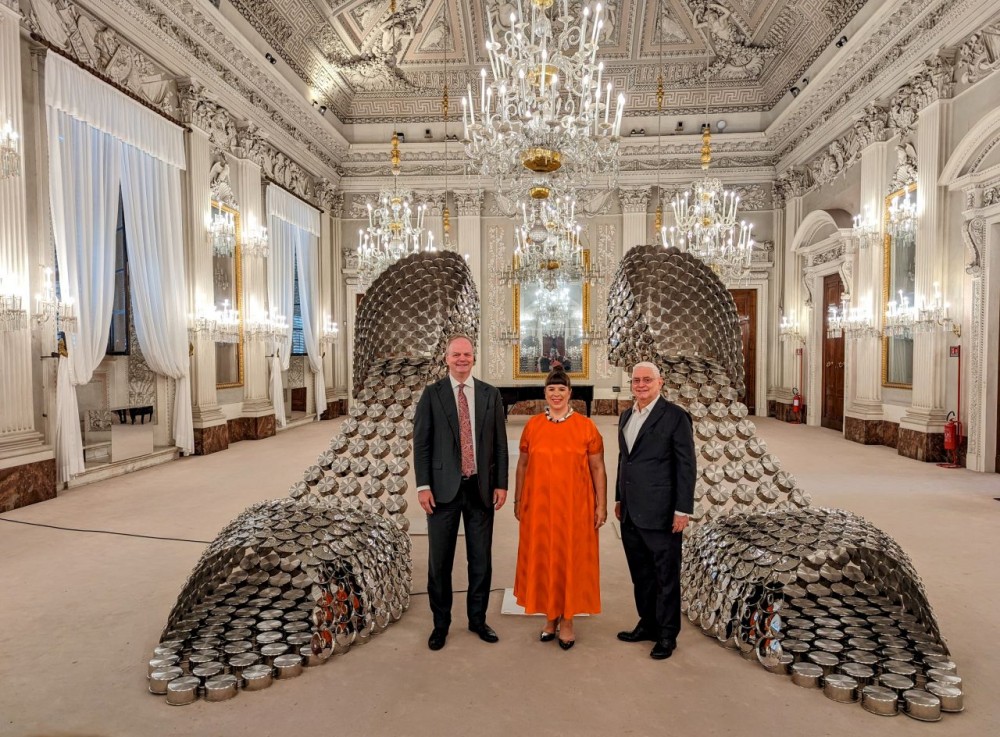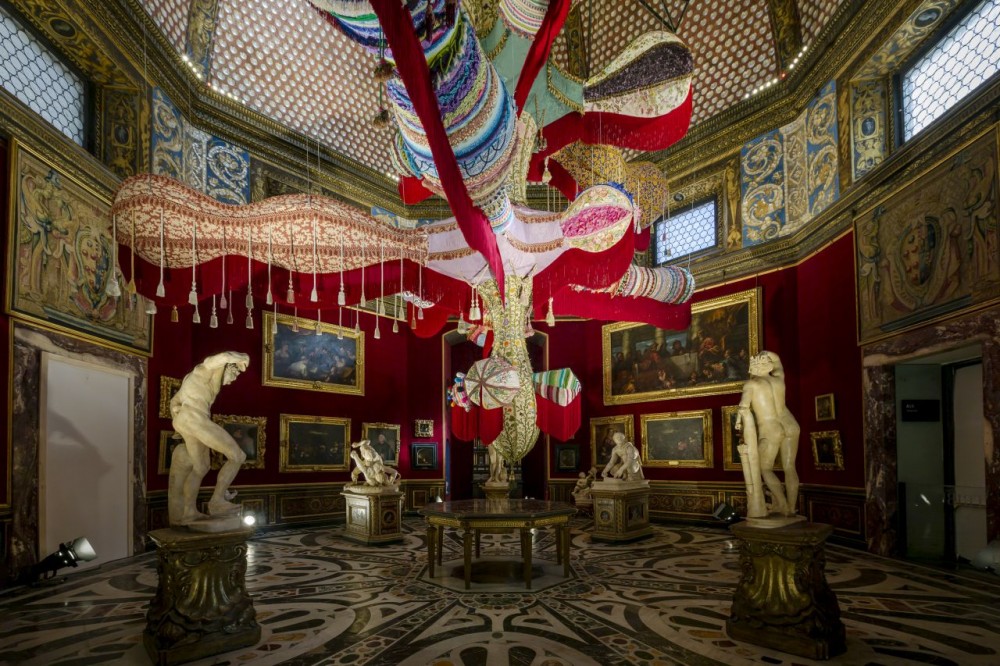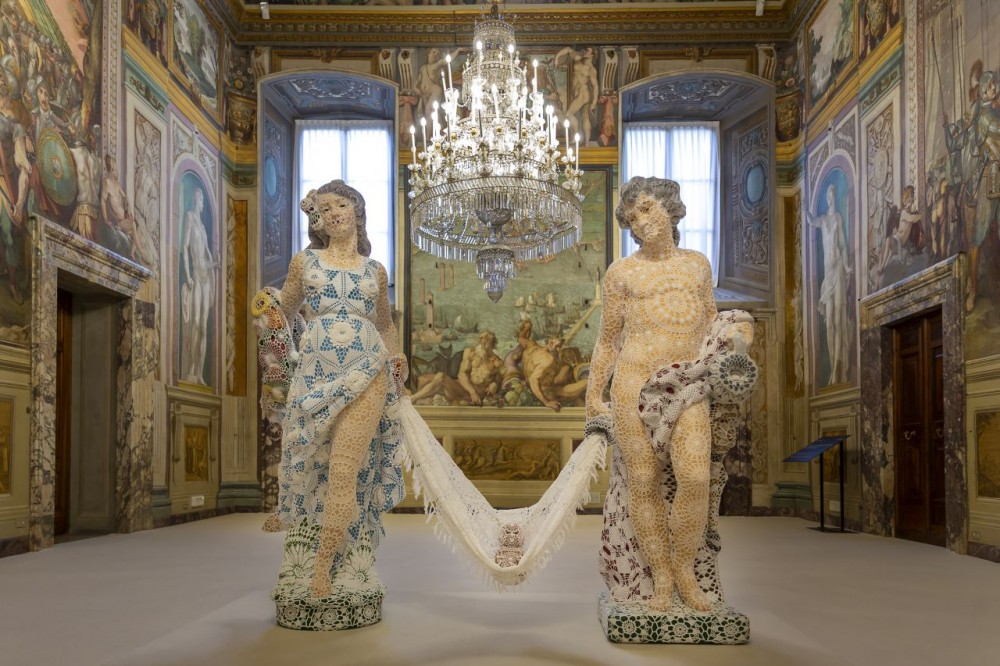The Uffizi becomes a stage for the installations of Joana Vasconcelos, the Portuguese artist who, by blending myth, history and tradition through irony and irreverence, challenges convention and gender stereotypes. ‘Between Sky and Heart’ is the title of the exhibition, curated by director of Uffizi Galleries Eike Schmidt and art curator Demetrio Paparoni. From 4 October 2023 to 14 January 2024, the Galleries will welcome three spectacular works, which reinterpret tradition and are rooted in both popular culture and the Portuguese Baroque. While on a technical level, the artist utilizes artisanal practices and appropriates objects related to domestic life, when it comes to design, she adopts an architectonic scale that requires an engineering approach and astounds the viewer at first glance.

Eike Schmidt, Joana Vasconcelos, Demetrio Paparoni
The White Hall in the Pitti Palace will host Marilyn, a colossal pair of high-heeled sandals, reminiscent of those worn by Marilyn Monroe in the film The Seven Year Itch. Amidst their silvery sheen, something strange becomes immediately apparent: the shoes are not composed of fashionable metallic links, but rather of stainless-steel pots accompanied by their corresponding lids. The sculpture thus arises from a paradox: everyday kitchen utensils interlock to comprise a stylish fashion item of monumental scale. In a contrast between feminine sensuality and the domestic role to which women have been traditionally relegated, Joana Vasconcelos transforms ordinary household objects by decontextualizing them and assembling them into a powerful weapon with which to challenge gender paradigms. The meaning of the work is revealed through the use of irony, a mode of communication that has always permitted Vasconcelos to confront thorny and controversial themes with a spirit of playfulness.

Lionel Balteiro for Atelier Joana Vasconcelos
An intricate interplay of fabric, wool, cotton, cords, stuffing, sequins, pearls, feathers and LEDs will loom from the ceiling of the Tribune of the Uffizi with the same power as the warriors who give it its name. Royal Valkyrie, one of the monumental hanging sculptures that comprise the Valkyries series, is an immense interweaving of colors in which the heroines of Norse mythology are revived and redefined. According to the enduring myth, the Valkyries have traversed the ages as merciless and unyielding warriors, endowed with superhuman strength used to conquer all forms of life; by adorning them with fabric, something historically associated with the female tradition, Joana Vasconcelos restores the sensuality and delicacy of which they have been deprived, while exalting their role as paladins of freedom. While the majesty of the sculpture exudes the warrior spirit of the myth, the enveloping sinuosity of the material enshrouds the Valkyrie with the empathy of one who has felt compassion and, according to Vasconcelos’ narrative, fights for a different perception of female power.

Lionel Balteiro for Atelier Joana Vasconcelos
The Bona Room in the Pitti Palace will host Happy Family, a surprising reinterpretation of the Christian “Holy Family” theme. The delicacy of ceramic and the lightness of wood, materials typically used for this kind of sculpture, are substituted with the hardness of concrete, whose strength and masculinity are enveloped in the femininity and tenderness of handmade crocheted pieces. While the lacework covers the nudity of the figures and appears to contain their sensuality, the transparency of the stitching amplifies their erotic charge. This dual and opposing push fills Happy Family with a marked vital force that is propagated by the choice of figures: in the place of Mary and Joseph, Vasconcelos selects two subjects from pagan tradition, Flora and Bacchus, who cradle the doll-child on a soft “naperon”, allowing him to partake in their pagan ritual. Through the subject’s metamorphosis, the divine is transposed into the atmosphere of a Dionysian rite; the original subject’s message of salvation is thus converted into an ode to life and rebirth, in an exaltation of eroticism and the joy of existence.
Director of the Uffizi, Eike Schmidt: “Marilyn Monroe’s high heels in monumental proportions, the traditional family unit (father-mother-child) transposed in irregular terms, a female warrior shrouded in colorful textures and crocheted frill: the installations of Joana Vasconcelos present an overtly feminist crescendo, yet without recrimination or rancor towards historical gender roles. It is, in fact, the very cheerful irony of her creations that unsettles us and makes us reflect on roles and on female empowerment, both efficacious and shattering”.
Curator Demetrio Paparoni: “Each time we visit an exhibition of Vasconcelos, it’s as though we witness new works, even when they are iconic pieces already known to the general public. Vasconcelos’ installation of the monumental Valkyrie in the Tribune of the Uffizi is, in and of itself, an extraordinary and inimitable event. Created with fabrics, embroideries, stuffing and soft and flexible material, the work adapts to and merges with its environment, which itself becomes a component of the installation. Equally extraordinary and inimitable is the presence in the Pitti Palace of other works, among them the well-known Marilyn, made of stainless-steel pots and lids. Displayed in the White Hall, Marilyn absorbs and restores the energy of this large bright room and of its magnificent stucco works, mirrors and chandeliers”.
Artist Joana Vasconcelos: “I am a contemporary artist participating in the creation of this historical moment, and I could never have dreamed of exhibiting in the same museum that conserves the works of Leonardo da Vinci, Michelangelo and Caravaggio. This invitation from the director of the Uffizi is a great honor. Regardless of whether the artists are alive or dead, what is most important is the dialogue generated among the works. The building itself serves as the frame for the artistic creations, regardless of the century from which they originate. This space has the magical power of erasing time; it’s like a time machine. The most wonderful thing about the Uffizi is its history of art.”
BIOGRAPHICAL NOTES
Born in Paris in 1971 to exiled Portuguese parents, Joana Vasconcelos returned to her homeland after the Carnation Revolution. In Lisbon, she developed her personal artistic style, characterized by a complex encounter between highly specialized artisanal practices and artistic experimentation. She garnered international success in 2005 at the first Venice Biennale curated by women, where Vasconcelos presented The Bride. In 2012, she was the youngest artist and the first woman to exhibit her work at the Palace of Versailles, while in 2018 she became the first Portuguese artist to hold a solo exhibition at the Guggenheim Bilbao. Vasconcelos’ approach to art challenges the confines between art, craftmanship and design, exploring questions of identity, culture and society.
https://www.uffizi.it/en/events/vasconcelos-uffizi

